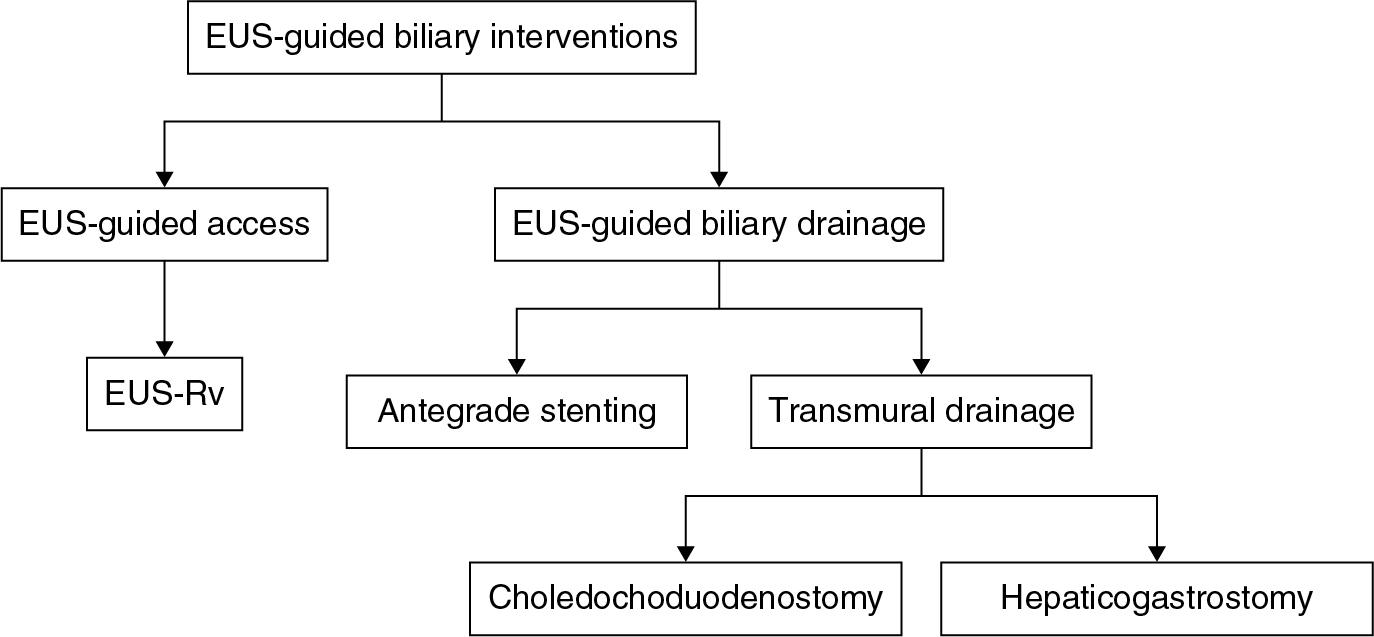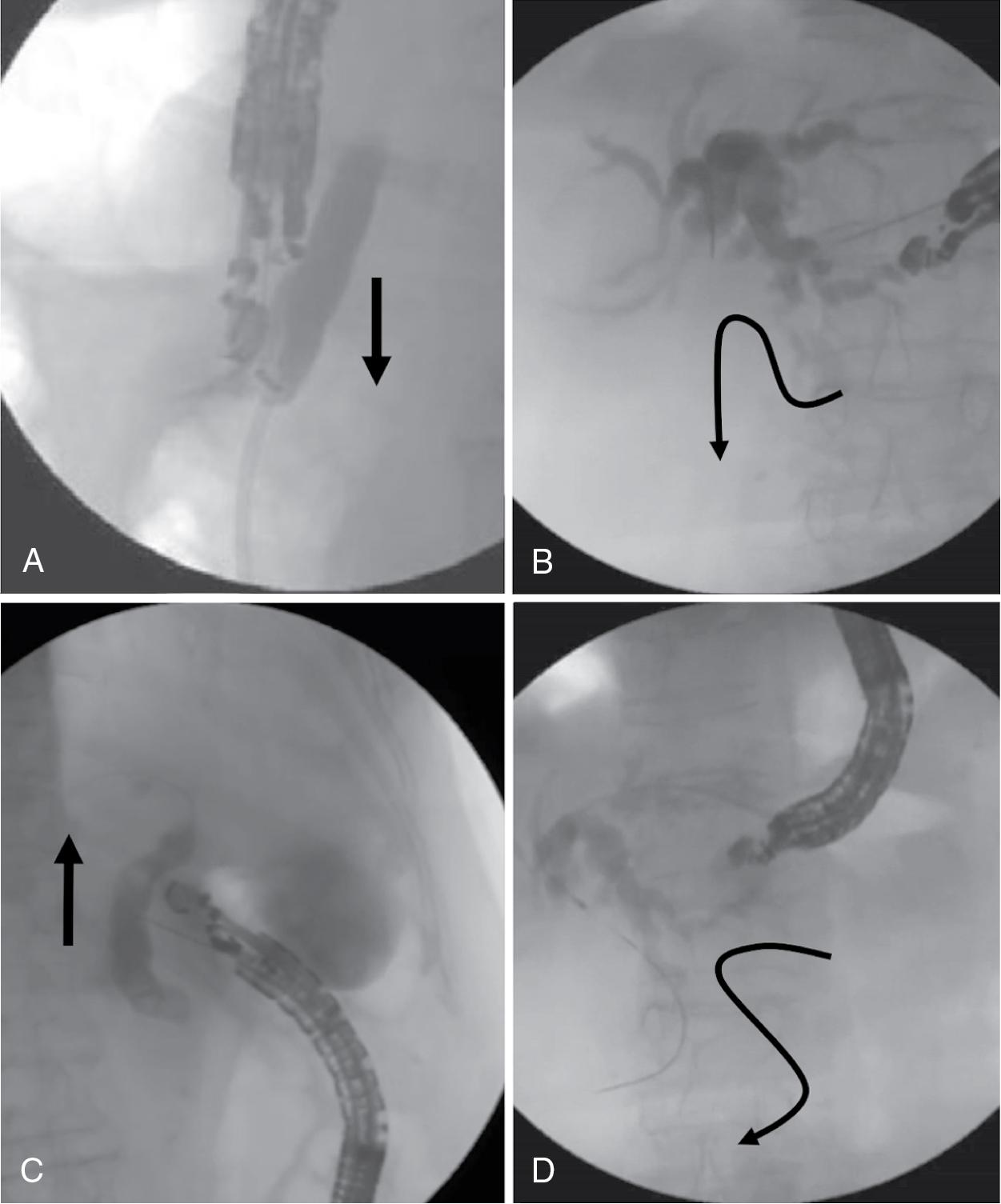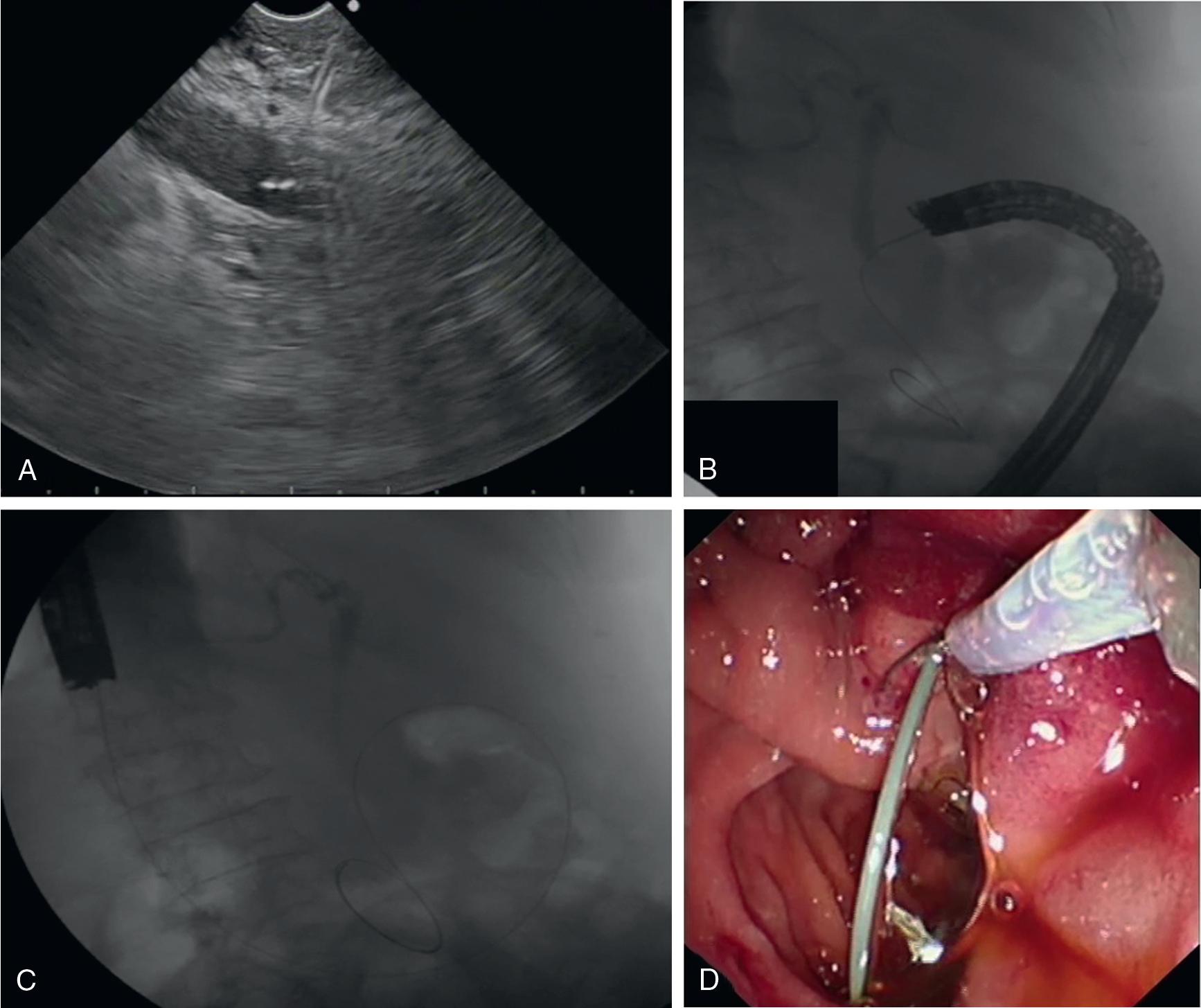Physical Address
304 North Cardinal St.
Dorchester Center, MA 02124
Endoscopic ultrasonography-guided biliary drainage (EUS-BD) is now generally preferred over percutaneous methods in patients with biliary obstruction and failed biliary cannulation during endoscopic retrograde cholangiopancreatography (ERCP), and should be considered in those with an inaccessible papilla.
EUS-BD is gaining popularity as an alternative for patients with nonresectable malignant hilar strictures and inadequate drainage of the left liver lobe by ERCP.
EUS-guided pancreatic duct drainage is a promising option for patients with symptomatic obstructed pancreatic duct but should be preserved for selected cases in expert centers.
Advanced techniques, high-level experience in EUS as well as ERCP, and dedicated devices are required to achieve superior efficacy and good safety profile of the procedures.
Endoscopic retrograde cholangiopancreatography (ERCP) is currently an indispensable tool for achieving endoscopic biliary and pancreatic duct drainage. Successful deep cannulation of the biliary tree can be achieved in ≥90% of ERCPs performed by an experienced endoscopist. Failure of cannulation could occur in patients with unusual anatomy or obstructing tumors, or when the papilla is inaccessible due to surgically altered anatomy. In patients with failed ERCP, biliary drainage could be achieved by percutaneous or surgical means, whereas pancreatic duct drainage could only be achieved by surgery. Percutaneous transhepatic biliary drainage (PTBD) is associated with technical success rates of 77% to 100%. However, PTBD is associated with adverse events rates in 6% to 31% of cases. , Moreover, it is often less preferred by patients as the external drainage tube causes inconvenience and tube-related problems. Surgical biliary drainage is associated with lower rates of recurrent biliary obstruction, but the invasive nature of the procedure causes more adverse events resulting in a longer hospital stay.
Recently, endoscopic ultrasonography (EUS)-guided biliary and pancreatic duct drainage has gained popularity as an alternative approach to achieve biliary or pancreatic drainage. Internal duct drainage can be achieved from different access routes using several techniques depending upon the anatomy and level of obstruction. Another advantage of EUS-BD is that this technique can be employed in the same session immediately after a failed ERCP. This chapter will provide an overview on the various approaches, techniques and accessories, advantages and disadvantages, the reported outcomes, and the adverse events of these techniques.
The current indications of EUS-BD are listed in Table 22.1 . The most common indication of EUS-BD is failed deep cannulation of the bile duct, an inaccessible papilla or hilar strictures with inadequate drainage of the left hepatic duct by ERCP. In the event of difficult cannulation, advanced ERCP techniques should achieve cannulation in 73.4% to 100% of the patients. Thus the use of EUS-BD as a salvage for failed ERCP should be uncommon. The papilla may be inaccessible due to (malignant) obstruction of the duodenum/stomach, previous duodenal stenting, or surgically altered anatomy. In these cases the bile ducts can be accessed from the stomach and then allow therapeutic biliary interventions. In patients with nonresectable malignant hilar strictures and inadequate drainage of the left hepatic duct by ERCP, endoscopic ultrasound-guided hepaticogastrostomy is gaining ground as a feasible alternative since it precipitates internal bile drainage.
| Procedural Indications |
|---|
|
|
|
|
The decision to perform EUS-BD in the event of failed ERCP should depend on the endoscopist and/or institutions success rates in achieving biliary cannulation with advanced ERCP techniques and the availability of endosonographers experienced in EUS-BD.
EUS-guided biliary interventions comprise of a group of procedures where the echoendoscope is used for bile duct access, drainage, and stone extraction. The types of procedures are shown in Fig. 22.1 .

EUS-guided biliary drainage (EUS-BD) procedures are divided as transmural or antegrade procedures depending on whether drainage is done in an antegrade fashion from the intrahepatic ducts toward the distal bile duct in the native biliary system (antegrade), or whether a permanent fistula is created for drainage (transmural). Antegrade procedures could be further classified by the location of the distal end of the stent into transanastomotic, suprapapillary, and transpapillary locations. It involves EUS-guided transhepatic puncturing of the intrahepatic ducts, followed by antegrade placement of a stent. EUS-guided antegrade stone extraction is preferred when the papilla or hepaticojejunostomy is not accessible, often in patients with surgically altered anatomy with a long afferent bowel loop. It involves EUS-guided antegrade advancement of stones across the ampulla using a balloon catheter.
Transmural drainage could be further classified by the anatomical site of drainage into choledochoduodenostomy (CDS) and hepaticogastrostomy (HGS). A CDS involves EUS-guided creation of a transmural fistula between the first part of the duodenum and the extrapancreatic common bile duct followed by placement of a stent. EUS-HGS involves EUS-guided creation of a transmural fistula between the left intrahepatic ducts and the stomach followed by stent placement. The use of a standard nomenclature is important, as individual procedures differ markedly in efficacy and risk profiles, and their outcomes should be analyzed separately.
The usual steps of any drainage procedure include needle puncture of the target organ, guidewire insertion, fistula tract dilation, and stent insertion. The standard preparation of patients and equipment required for the procedure are listed below. The toolbox for instruments and accessories commonly used is shown in Table 22.2 .
| Categories | Tools |
|---|---|
| Needles |
|
| Guidewires |
|
| Tract dilation |
|
| Stents |
|
Patients should be checked for blood type and screen, and any coagulopathy should be corrected. Patients should temporarily discontinue anticoagulants and dual antiplatelet agents prior to the procedure. The patient should be fasted for 4 to 6 hours before the procedure. Prophylactic broad-spectrum antibiotics, complemented by a rectal nonsteroidal antiinflammatory drug in case of a pancreatic duct intervention, should be given prior to the procedure. The procedures should be performed under deep sedation or general anesthesia. The procedure can be performed with the patient in the supine, prone, or left lateral position. Carbon dioxide insufflation should be employed to reduce the risk of pneumoperitoneum.
EUS-guided drainage procedures should be performed using a linear array therapeutic echoendoscope with a 3.8-mm working channel. Forward viewing therapeutic echoendoscope could be used if a transduodenal puncture for EUS-Rv or CDS is planned. This type of echoendoscope offers a larger degree of angulation for needle puncture and guidewire manipulation, and may reduce the risk of double penetration of the duodenum mucosa. ,
A 19-gauge needle should be used for duct puncture. The use of needles made with nitinol may improve the maneuverability of the echoendoscope in the duodenum. , A steerable access needle might aid in guiding the guidewire into the desired direction. A 0.025- or 0.035-inch guidewire should be used to negotiate the bile duct. Curved tip hydrophilic guidewires may improve the steerability of the wire and prevent cannulation of side branches in case of pancreatic duct drainage. In patients with smaller ducts or ducts located at an acute angle, a 22-gauge needle could be used but only a 0.018- or 0.021-inch guidewire would pass through the needle. These wires are soft and difficult to manipulate and will need to be handled with care.
Dilation of the needle tract could be achieved by the use of mechanical or cautery devices.
Mechanical dilation of the tract could be achieved by a tapered dilating catheter, hydrostatic balloons, or occasionally a screw-type stent retriever. , Cautery devices include needle-knife sphincterotome or a 6- or 8.5-Fr coaxial cystotome. The use of mechanical dilation may in principle reduce the risk of damaging the surrounding structures. However, it is sometimes difficult to insert these instruments into the tract for dilation. Hence the use of (pure cutting current) cautery is frequently required. When using cautery, a coaxial cystotome is the preferred instrument, because the use of a needle-knife has been shown to be a risk factor for developing adverse events. This may be a result of the different path of insertion of the needle on the sphincterotome to the guidewire. To date, there have been no comparative trials to clarify the relative value of available devices. The selection of devices depends on personal experience and availability. Multiple devices are often serially employed for fistula tract dilation.
When performing EUS-Rv or EUS-AG, the consideration for stents is generally similar to that of ERCP, whereas for transmural drainage procedures, because the integrity of the anastomosis is dependent on the properties of the stent, the choice of stent should be made cautiously. When EUS-guided biliary drainage was first developed, plastic stents were commonly used. However, the risk of bile or pancreatic leak after plastic stent placement may be higher when compared to metal stents. Thus the use of fully or partially covered metallic stents (self-expandable metallic stents [SEMS]) is usually favored in EUS-BD, whereas for EUS-PD, plastic stents are usually used as the diameter of the PD is too small to accommodate biliary SEMS. When inserting metal stents in EUS drainage procedures, there are several considerations. Fully covered SEMS (FCSEMS) are prone to migration. This may be catastrophic when it is used for transmural drainage procedures, as early migration of the stent will cause dehiscence of the anastomosis and free perforation or leakage. This problem is generally overcome by using an oversized FCSEMS, partially covered SEMS, or SEMS with antimigratory design for better anchorage. One can also insert a double pigtail stent into the FCSEMS as anchorage. Furthermore, after EUS-guided drainage, the target organ will collapse and the stent may impinge onto the walls of the organ causing erosion, bleeding, or stent obstruction.
In view of these considerations, several EUS-specific stents have been developed. They can be broadly classified into lumen-apposing metal stents (LAMS) or tubular stents. For the LAMS, there are several design characteristics common to the devices ( Fig. 22.2 ). These stents are very short in length ranging between 1 and 3 cm. The ends of the stents are flanged to generate some lumen-apposing force and improve the antimigratory properties of the stent. However, the forces generated by different stent designs are markedly different, and choosing the correct stent for the clinical situation is important. Regarding tubular stents, they may be uncovered at one side to provide anchorage and be fully covered at the other end to bridge the anastomosis from the target organ to the lumen. Other types of tubular stents have antimigratory flaps to reduce the risk of migration.

Cautery-equipped stent delivery systems also have become available. The cautery at the tip of the sheath allows a single-step puncture of the target organ and delivery of the stent, thereby avoiding the need for multiple device exchanges during the procedure. The system may thus reduce the chances of bile leak or wire dislodgement. The system has been used in CDS and EGBD. Dedicated stents for each procedure will be discussed in the respective sections.
The main aim of EUS-Rv is to insert and pass a guidewire across any stenosis through the papilla to guide cannulation by ERCP. Manipulation of the guidewire is the most difficult part of the procedure. For successful guidewire manipulation, endoscopist-controlled wire guidance may be helpful as compared to assistant-controlled wire guidance, similar to wire-guided biliary cannulation. Selection of an appropriate site for puncture has a tremendous influence on the direction of the guidewire and affects the ease of wire manipulation. The use of a short-wire system also has been described to improve the ease of wire manipulation.
For EUS-Rv, the bile duct could be punctured at the second part of the duodenum, the first part of the duodenum, or the left intrahepatic duct ( Fig. 22.3 ). In the second part of the duodenum, the linear echoendoscope is in a short-scope position. The direction of needle puncture is toward the papilla, and the pathway of the guidewire would be in line with the direction of the needle. Wire manipulation would be easiest in this position, but the scope position is unstable. In the first part of the duodenum, the common bile duct is directly behind the duodenum, and needle puncture is easy. However, the echoendoscope is frequently in a long-scope position, and the direction of the needle would be toward the liver hilum. Thus the guidewire would have a tendency to pass toward the hilum instead of the papilla. Regarding the left intrahepatic ducts, one prerequisite is that adequate duct dilation must be present. The authors prefer to puncture close to the junction between segment 2 and 3 ducts as it improves the ease of guidewire manipulation toward the papilla and avoids unnecessary entry into intrahepatic side branches.

The bile duct is punctured with a 19-gauge needle from one of the positions as described previously.
Bile is aspirated to confirm puncture of the bile duct and prevent bile leak before injection of the contrast medium.
Contrast is injected to perform a full cholangiogram.
A straight or curved tip, 0.025- or 0.035-inch guidewire is inserted through the needle into the bile duct to negotiate across any stenosis and pass through the papilla.
Once the guidewire has passed through the papilla, the insertion of an excess of guidewire is continued and made to loop in the duodenum.
The echoendoscope is then changed to a duodenoscope. The papilla can be cannulated alongside the guidewires. If this fails, the guidewire can be retrieved by a snare or forceps and pulled through the working channel of the scope. Slippage of the wire can occur during retrieval, and care must be taken to avoid accidentally retracting the guidewire back into the papilla.
Once the guidewire is retrieved into the duodenoscope, the procedure can continue similar to an ERCP procedure.

Become a Clinical Tree membership for Full access and enjoy Unlimited articles
If you are a member. Log in here